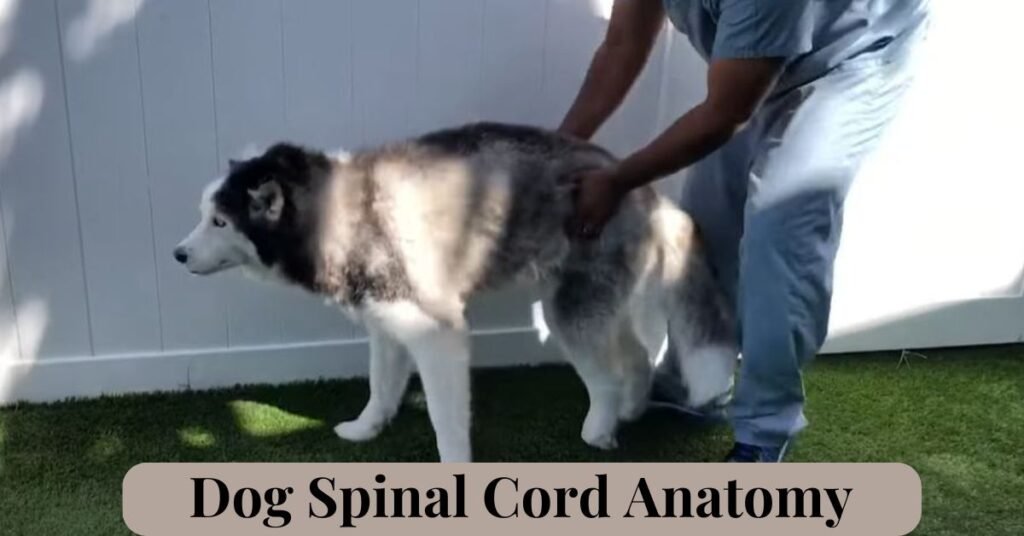Introduction
Understanding the spinal cord anatomy of dogs is very important. One essential component of the neurological system is the spinal cord. It helps dogs move, feel, and react to their environment. Knowing about the spinal cord can help dog owners take better care of their pets and understand any health problems that may arise.
What is the Spinal Cord?
A long, thin bundle of nerves that runs down the back from the brain is called the spinal cord. It is a crucial part of the central nervous system, playing a key role in transmitting signals between the brain and the rest of the body. The spinal cord is protected by the spinal column, which is made up of vertebrae, or spinal bones. These vertebrae help safeguard the spinal cord from injury.
The spinal cord is covered by three layers of protective tissues called meninges, which also contribute to its protection. It starts at the base of the skull and continues down to the lumbar region of the lower back. The spinal cord is responsible for both motor functions, such as movement, and sensory functions, such as feeling sensations like pain, heat, and touch.
Parts of the Spinal Cord
- Cervical Spine: This is the neck area. It has seven vertebrae, labeled C1 to C7.
- Thoracic Spine: This is the upper back area. It has thirteen vertebrae, labeled T1 to T13.
- Lumbar Spine: This is the lower back area. It has seven vertebrae, labeled L1 to L7.
- Sacral Spine: This is the area near the hips. It has three vertebrae, labeled S1 to S3.
- Caudal Spine: This is the tail area. The number of vertebrae here can vary.
Each section of the spinal cord has specific functions and controls different parts of the dog’s body.
Functions of the Spinal Cord
The spinal cord has two main functions:
- Motor Function: It sends signals from the brain to the muscles, telling them to move.
- Sensory Function: It carries signals from the body to the brain, allowing the dog to feel sensations like pain, heat, and touch.
Common Spinal Cord Problems in Dogs
Intervertebral Disc Disease (IVDD)
Intervertebral Disc Disease (IVDD) is a prevalent condition in dogs, particularly in certain breeds like Dachshunds and French Bulldogs. It occurs when the discs between the vertebrae, which act as cushions, become damaged or herniated. This can lead to compression of the spinal cord, resulting in pain, neurological deficits, and in severe cases, paralysis.
Symptoms of IVDD
- Pain in the back or neck: Dogs may show signs of discomfort, reluctance to move, or sensitivity to touch in the affected area.
- Difficulty walking: This can range from mild to severe, depending on the extent of spinal cord compression.
- Weakness in the legs: Dogs may exhibit weakness or even partial paralysis in one or more limbs.
- Loss of bladder or bowel control: In advanced cases, dogs may lose control over urination and defecation due to impaired nerve function.
Treatment of IVDD
- Rest and medication: Mild cases may improve with strict rest and anti-inflammatory medications to reduce swelling and pain.
- Surgery: Severe cases often require surgical intervention to remove the damaged disc material and relieve pressure on the spinal cord.
- Physical therapy: Post-surgery, rehabilitation including physical therapy and controlled exercise helps in recovery and prevents recurrence.
Spinal Cord Injuries
Spinal cord injuries in dogs often result from traumatic incidents such as being hit by a car, falling from a height, or sudden twisting motions. These injuries can cause immediate pain and loss of function.
Symptoms of Spinal Cord Injuries
- Sudden pain: Dogs may cry out or show signs of distress immediately after the injury.
- Inability to move: Depending on the severity and location of the injury, dogs may be unable to move their limbs.
- Paralysis: Partial or complete paralysis of one or more limbs is common in severe cases.
- Loss of sensation: Dogs may lose the ability to feel touch or pain in the affected area.
Treatment of Spinal Cord Injuries
- Immediate veterinary care
- Surgery
- Physical therapy
How to Keep Your Dog’s Spine Healthy
Regular Exercise
Regular exercise helps keep your dog’s muscles strong and supports the spine. Activities like walking, running, and playing are great for your dog.
Healthy Diet
A healthy diet is important for your dog’s overall health. Make sure your dog gets the right amount of nutrients, including vitamins and minerals that support bone health.
Regular Vet Check-ups
Regular vet check-ups can help catch any spinal problems early. Your vet can give you advice on how to keep your dog’s spine healthy.
Safe Environment
Make sure your dog lives in a safe environment. Avoid situations where your dog might get injured, like jumping from high places or running on slippery floors.
Conclusion
Understanding dog spinal cord anatomy is essential for every dog owner. It helps you recognize symptoms of spinal problems early and seek proper treatment. By providing regular exercise, a healthy diet, regular vet check-ups, and a safe environment, you can help keep your dog’s spine healthy and prevent injuries.
